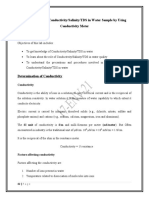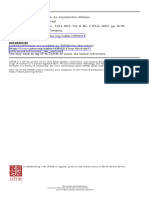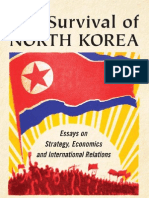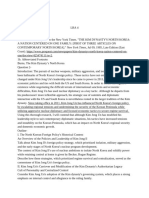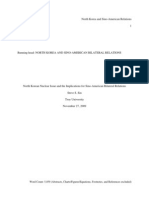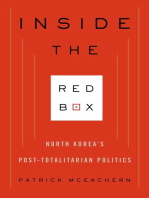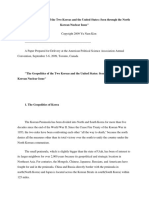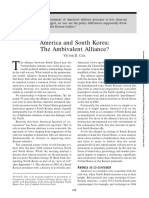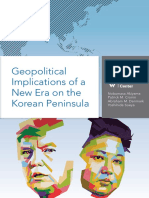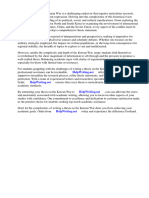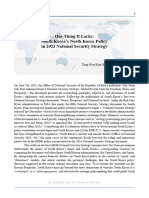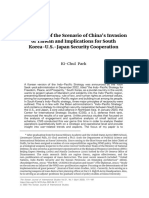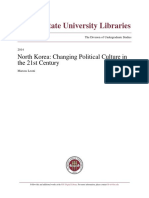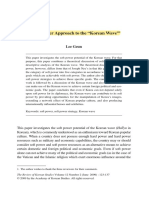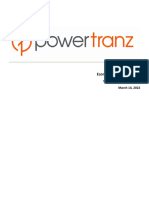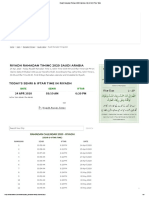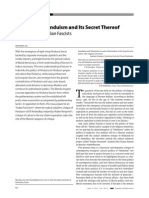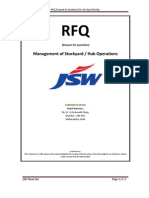LCP 016
LCP 016
Uploaded by
bestebesteCopyright:
Available Formats
LCP 016
LCP 016
Uploaded by
bestebesteOriginal Title
Copyright
Available Formats
Share this document
Did you find this document useful?
Is this content inappropriate?
Copyright:
Available Formats
LCP 016
LCP 016
Uploaded by
bestebesteCopyright:
Available Formats
International Relations of the Asia-Pacific Volume 10 (2010) 93127
doi:10.1093/irap/lcp016 Advance Access published on 10 September 2009
Collective identity formation
on the Korean Peninsula:
United States different North
Korea policies, Kim Dae-
Jungs Sunshine Policy, and
United States South Korea
North Korea relations
Young Chul Cho
Political Science & International Studies, Yonsei University,
134 Sinchon-dong, Seodaemun-gu, Seoul, Republic of Korea
120-749
Email: youngchul.cho@gmail.com
Abstract
Focusing on the US Clinton and Bush administrations dissimilar security
policies and practices toward the Korean Peninsula, this article aims to
examine how the two different external security environments shaped
South Koreas collective identity in relation, respectively, to the United
States and North Korea, and the Sunshine Policy in different ways, with
a temporal focus on the Kim Dae-Jung administration (1998 2003).
In so doing, this article will investigate the following substantive ques-
tions: what are the reason and implication of harmony between South
Received 23 December 2008; Accepted 10 August 2009
International Relations of the Asia-Pacific Vol. 10 No. 1
# The author [2009]. Published by Oxford University Press in association with the
Japan Association of International Relations; all rights reserved.
For permissions, please email: journals.permissions@oxfordjournals.org
Downloaded from https://academic.oup.com/irap/article-abstract/10/1/93/728921
by Hanyang University, ERICA Academic Info. CTR Lib. user
on 21 November 2017
94 Young Chul Cho
Korea US alliance identity and inter-Korean national identity in South
Korea during the Clinton administration? In contrast, what are the
reason and implication of discord between the two identities during
the Bush administration? Related to these questions, this article pre-
sents two analytical arguments on the formation of South Koreas col-
lective identity associated with the Sunshine Policy, along with an
International Relations theoretical argument implicated in the empirical
analysis.
1 Introduction
Since the Korea War started in 1950, the security culture on the Korean
Peninsula has been antagonistic between the South KoreaUS alliance
and North Korea. To dismantle this hostile security culture (what is
often called, the Cold War structure), in 1998, the Kim Dae-Jung admin-
istration (hereafter, the Kim administration) in South Korea
implemented what President Kim Dae-Jung (hereafter, President Kim;
quoted in Moon, 1999, p. 37) calls a Sunshine Policy which seeks to
lead North Korea down a path toward peace, reform and openness
through reconciliation, interaction and cooperation with the South. In
seeking to socialize North Korea, the Sunshine Policy was also directed
at regional countries in Northeast Asia, since the Cold War structure on
the Korean Peninsula has existed at two layers concurrently and interac-
tively: the inter-Korean layer, on the one hand, and the regional layer, on
the other. Internationally, just as North Korea has been the United
States bete noire, America has been North Koreas loathed and feared
Other since the Korean War (195053). This antagonistic US North
Korean relationship has often had a negative impact on South Koreas
national security in a globalizing world after the Cold War, as shown in
the 1994 nuclear crisis in Korea. It is also widely accepted that the vari-
ation in the US North Korea relations has heavily influenced (and will
significantly influence) progress in both inter-Korean relations and
JapanNorth Korea relations.
With this international dimension of Koreas Cold War structure in
mind, the Kim administration urged that, by gradually reforming and
opening itself, North Korea should join the international community
(more specifically, the existing, American-shaped international security
structure) for its own good ensuring the Norths national survival and
Downloaded from https://academic.oup.com/irap/article-abstract/10/1/93/728921
by Hanyang University, ERICA Academic Info. CTR Lib. user
on 21 November 2017
Collective identity formation on the Korean Peninsula 95
gaining substantial economic assistance from the outside world. At the
same time, in claiming that North Korea is most dangerous when it is iso-
lated (Kim, 2004b, p. 51), the Kim administration encouraged regional
countries ( particularly, the United States) and international organizations
to engage with North Korea more to the point, to provide the inter-
national living space in which North Koreas external sovereignty can be
recognized. Seoul believes that those two-way processes help North Korea
to become a member of the international community, while easing North
Koreas deep-seated fear of the hostile outside world and learning inter-
national norms. In the long run, socialized North Korea will not be an
international outcast and threat to international security, thus increasing
peace and stability in Korea as well as Northeast Asia. In Wendts (1999)
words, by implementing the Sunshine Policy, South Korea as a driving
force attempted to transform the ossified Hobbesian security culture into
the Lockean (or even Kantian) security culture in Northeast Asia. This
transformative process of security culture has required a shift in the distri-
bution of shared ideas of perceiving friend and foe in the region, which
lead then to realign their collective identity among regional countries: that
is, at least North Korea must come to be the friendly Other of South
Korea, the United States, and Japan, even if it cannot be part of liberal,
democratic us. In this sense, Seouls Sunshine Policy is not simply South
Koreas tactical engagement demarche of coping with the on-going North
Korean problem, but is the state-driven identity project reconfiguring the
existing mapping of collective identity in Northeast Asia in the post-Cold
War era of globalization. Related to the Souths engagement policy
toward the North, therefore, the issue of collective identity is crucial to
having a more in-depth understanding of South Koreas national security
today, and of the increasing dynamic of inter-Korean relations which
project implications for security and diplomacy in Northeast Asia.
In traditional security studies, nonetheless, little is known of South
Koreas national security associated with the Sunshine Policy in terms of its
evolving collective identity in the region. To contribute to filling this gap in
the literature, by addressing the question of how a significant change in the
international security environment affected South Koreas national security
during the Kim administration, this article is to explore the formation of
South Koreas collective identity which has, in turn, informed its interest
and policy at the turn of the twenty-first century. More specifically, focusing
on the US Clinton and Bush administrations contrasting security policies
Downloaded from https://academic.oup.com/irap/article-abstract/10/1/93/728921
by Hanyang University, ERICA Academic Info. CTR Lib. user
on 21 November 2017
96 Young Chul Cho
and practices toward the Korean Peninsula, this article aims to examine
how the two different external security environments shaped South Koreas
collective identity in relation, respectively, to the United States and North
Korea, and the Sunshine Policy in different ways, with a temporal focus on
the Kim administration (19982003). In so doing, this article will investi-
gate the following substantive questions: what are the reason and impli-
cation of harmony between South KoreaUS alliance identity and
inter-Korean national identity in South Korea during Clintons second
term? In contrast, what are the reason and implication of discord between
the two identities during Bushs first term?
In order to address the two questions and to explore the configuration
of South Koreas collective identity under different regional security
environments, the following analysis is organized in three sections. The
first section briefly presents the central theme of sociological constructi-
vism as this articles underpinning theoretical stance, addressing how
South Koreas collective identity will be understood and used to explain
US influence on the Sunshine Policy. In comparing Clintons period with
Bushs period, the second section considers the US security policy
toward the Korean Peninsula to reveal the external, social security
context in which South Korea acted and the Sunshine Policy had been
implemented. To provide a nuanced understanding of South Koreas
evolving foreign relations with its traditional ally (America) and long-
term enemy (North Korea), the second section thoroughly examines the
triangular interactions among the United States, South Korea, and
North Korea, and its impacts on South Koreas sense of (in)security and
the Sunshine Policy in chronological order. Here, methodologically, this
article deals with various South Korean and the US governmental docu-
ments, media output, South Korean and the US policy-makers remarks.
The secondary literature will also be screened. On the basis of the sec-
tions detailed narrative, the final section presents two analytical argu-
ments on the formation of South Koreas collective identity associated
with the Sunshine Policy, along with an International Relations (IR)
theoretical argument implicated in the empirical analysis.
2 Theoretical context
In the context of sociological (or conventional) constructivism in IR,
Katzenstein (1996, p. 2) argues that security interests are defined by
Downloaded from https://academic.oup.com/irap/article-abstract/10/1/93/728921
by Hanyang University, ERICA Academic Info. CTR Lib. user
on 21 November 2017
Collective identity formation on the Korean Peninsula 97
actors who respond to cultural factors. In this process, the concept of
identity is crucial, since it functions as a critical link between environ-
mental structures and interests (Jepperson et al., 1996, p. 59). It is thus
crucial for sociological constructivists to examine how a state identity,
which in turn informs its interest and policy, are constructed, in relation
to its culturalinstitutional environment. In addition, from a structuralist
perspective, sociological constructivism is interested in how structures of
constructed meaning, embodied in norms and identities, affect what
states do (Jepperson et al., 1996, p. 66). Yet, it should be note that the
structures serve to produce permissive conditions for state action, rather
than determine it.
This article accepts the sociological constructivist ontological assump-
tion that states are ontologically prior to the states system, [and the]
state is pre-social relative to other states in the same way that the human
body is pre-social . . . systems of states presuppose states, and so if we
want to analyze the structure of those systems we cannot de-center
their elements all the way down (Wendt, 1999, p. 198, 244). In his theor-
etical work, Social Theory of International Politics, Wendt (1999,
pp. 224233) discusses four sorts of state identity: (1) corporate; (2)
type; (3) role; and (4) collective. As Wendt (1999, p. 232) explains, the
US cannot be a state without its monopoly on organized violence (cor-
porate), a capitalist state without enforcing property rights (type), a
hegemon without its clients (role), and a member of the West without its
solidarity with other Western states (collective).1
Of these, this article focuses on the concept of collective identity to
explore how South Koreas social relations with the United States and
North Korea had been evolved during the Kim administration in the fol-
lowing section. According to Wendt (1999, p. 229), the collective identity
is a distinct combination of role and type identities, one with the causal
power to induce actors to define the welfare of the Other as part of that
of the Self, to be altruistic. Altruistic actors may still be rational, but
the basis on which they calculate their interests in the group or team.
In this sense, constructing collective identity is more external than
internal, being tied to the process of positive or negative identification
among states.
1 For a criticism of sociological constructivisms state-centric features, see Campbell (1998),
Zehfuss (2001) and Callahan (2003).
Downloaded from https://academic.oup.com/irap/article-abstract/10/1/93/728921
by Hanyang University, ERICA Academic Info. CTR Lib. user
on 21 November 2017
98 Young Chul Cho
Wendts well-known typology of anarchical culture Hobbesian,
Lockean, and Kantian implies the different level of collective identity
among states. As such, the collective identity is the crucial intersubjective
meanings that construct social fabric of international politics. This iden-
tity emerges from social interaction, and perhaps changes through social
interactions in international relations. States interacting in a given culture
come to know one another as the bearers of certain identities. When this
happens, the states appeal to certain prospects as to each others actions
based on these identities (Wendt, 1999, pp. 318343). In this respect, the
collective identity subsumes reputation; having a particular collective iden-
tity is enough to supply the necessary diagnostic information about a
states likely behavior with reference to other states in particular cultures
(Hopf, 1998, p. 190). In short, collective identity matters in international
politics, since it informs not simply what states do and should be, but how
states interpret other states intention and action under anarchy.
Against this theoretical backdrop, as mentioned before, this article
pays special attention to South Koreas collective identity formation,
since it helps to explain contrasting the US North Korea policies influ-
ence on South Koreas national security and Sunshine Policy, showing
the process of South Koreas positioning of itself vis-a-vis the United
States and North Korea. In this sense, to capture different pictures of
South Koreas collective identity formation under different regional
security environments, the following empirical section (Section 3) details
the triangular interactions among the United States, South Korea, and
North Korea during the Kim administration, while dividing the period
of Kim into two: the Clinton administration period (19982000), on the
one hand, the Bush administration period (200003), on the other. This
temporal-comparative, detailed narrative traces the effects that the
Clinton and Bush administration had on South Koreas relations with its
core ally (America) and traditional enemy (North Korea), and the
Sunshine Policy, revealing that South Koreas collective identity func-
tioned as a critical link between its international environment and
implementation of the Sunshine Policy. Section 4, then, offers a more
sustained, in-depth analysis of Section 3s empirical treatment. This
article will analytically present that, although South KoreaUS relations
appeared to be so congenial during Clintons second term, the rift in tra-
ditional South KoreaUS alliance identity against the North Korean
threat was actually and paradoxically rooted in the Sunshine Policy and
Downloaded from https://academic.oup.com/irap/article-abstract/10/1/93/728921
by Hanyang University, ERICA Academic Info. CTR Lib. user
on 21 November 2017
Collective identity formation on the Korean Peninsula 99
Clintons support for it. Here, the turn toward Bushs hard-line approach
to North Korea made visible the hidden rift in the traditional South
KoreaUS alliance identity, though did not directly cause it. And,
unlike the period of Clinton, South Koreas formation of collective iden-
tity was deeply unstable during Bushs first term. Under this circum-
stance, Seoul experienced great difficult in articulating and seeking its
security interests between the United States and North Korea, and in dis-
mantling Koreas Cold War which is the Sunshine Policys foremost goal
seemed to be untenable.
3 The two periods compared
3.1 The Clinton administration and the Sunshine Policy
(1998 2000)
The Clinton policy toward the Korean Peninsula. Regarding President
Kims Sunshine Policy, the Clinton administration (WH, 1998, pp. 42
43) articulated its approach to the Korean Peninsula as follows:
President Clinton expressed strong support for President Kims vision
of engagement and efforts toward reconciliation with the North. The
United States is working to create conditions of stability by maintain-
ing solidarity with our South Korean ally, . . . ensuring that an isolated
and struggling North Korea does not opt for a military solution to its
political and economic problems.
In line with this, the US Secretary of State Madeleine Albright (1998,
p. 60) stated that the United States had sought to move North Korea
toward a less belligerent and more open approach to the world, in part-
nership with South Korea, close consultation with Japan, and
cooperation with China and others. Through this US stance toward the
Korean Peninsula, what emerges here is the idea of a soft landing
approach to North Korea (Harrison, 1997). This idea assumes that,
although skeptical of the North Korean regime, engagement is the realis-
tic and rational option for preventing the rapid deterioration of military
insecurity and the sudden collapse of North Korea: both cases
may result in devastating outcomes in the region, such as large-scale
refugee movements or the second Korean War, in which the United
States should become involved. With these concerns in mind, the soft
Downloaded from https://academic.oup.com/irap/article-abstract/10/1/93/728921
by Hanyang University, ERICA Academic Info. CTR Lib. user
on 21 November 2017
100 Young Chul Cho
landing approach aims to seek the gradual evolution of the North
Korean regime accompanied by various economic and social reforms
which help it to become a responsible member of the international com-
munity. Moreover, through the various engagement projects, North
Korean reforms should closely be supported and monitored by govern-
mental and non-governmental actors in the region (Bleiker, 2005,
pp. 8790).
In this respect, although the Clinton administration did not trust the
North Korean regime to any great degree, it no longer regarded North
Korea as an immutable threat per se, as during the Cold War era. In
fact, Clintons soft-landing approach and Kims Sunshine Policy were
functionally similar, both assuming that the North Korean regime could
change from being a hostile rule-breaker to a less aggressive rule-abiding
country. Plus, both policies sought not to demolish but reform North
Korea through constructive engagement. In this sense, Seoul and
Washington largely shared ideas about how to perceive and deal with
Pyongyang under the Clinton administration, which considerably under-
pinned and consolidated a sense of one team, the alliance mentality
between the United States and South Korea. In addition, Washingtons
soft-landing approach created favorable external conditions for Seouls
Sunshine Policy.
The apparent thawing of Koreas Cold War. On taking office in February
1998, President Kim actively promoted the Sunshine Policy to improve
inter-Korean relations. Only 6 months later, however, the Korean
Peninsula again encountered serious tensions between North Korea and
its neighbors. In August 1998, The New York Times 2 and The
Washington Post 3 revealed that North Korea might develop secret
nuclear programs at the underground facility in Kumchangri, which was
clearly interpreted as the violation of the US North Korea Agreed
Framework4 that was designed to resolve the North Korean nuclear
crisis in 1994. Amid the growing skepticism about North Koreas
2 North Korea Site an A-Bomb Plant, U.S. Agencies Say, New York Times, 17 August 1998.
3 Activity Suggests North Koreans Building Secret Nuclear Site, Washington Post, 18 August
1998.
4 Available at http://www.kedo.org/pdfs/AgreedFramework.pdf (last accessed on 1 May
2006).
Downloaded from https://academic.oup.com/irap/article-abstract/10/1/93/728921
by Hanyang University, ERICA Academic Info. CTR Lib. user
on 21 November 2017
Collective identity formation on the Korean Peninsula 101
willingness to freeze its nuclear program, to make matters worse, on 31
August, 1998, North Korea fired a rocket into the North Pacific via the
East Sea (the Sea of Japan) that the regional countries initially suspected
to be a test-firing of the newly-developed medium-range Taepodong-1
ballistic missile. After firing the rocket, North Korea officially announced
that it had successfully launched a satellite that was orbiting the earth.
On 14 September, 1998, the US State and Defense spokespersons offi-
cially acknowledged that the firing was an abortive bid to send a satellite
into orbit. Despite the fact that it was a not missile but a satellite, the
perceived capabilities of the North Korean rocket, especially its range,
immediately alarmed Seoul, Tokyo, and Washington (Oberdorfer, 2001,
pp. 410414; Cumings, 2004, pp. 7689). More importantly, the North
Korean rocket appeared to prove the validity of the Report of the
Commission to Assess the Ballistic Missile Threat to the United States 5
(the so-called Rumsfeld report), published 6 weeks before the firing,
which stressed the necessity of a national missile defense (NMD) plan.
According to the report, North Korea . . . poses a major threat to
American interests, and potentially to the United States itself . Although
they took the North Korean rocket seriously, Kim and Clinton did not
scrap the Agreed Framework and the Korean Peninsula Energy
Development Organization (KEDO)6 project. If scrapped, North Korea
would restart its nuclear activities without being bound by any inter-
national agreements. Moreover, the Clinton administration (DD, 1998,
p. 23) saw a properly functioning Agreed Framework as the best vehicle
available for . . . creating an opening to pursue other issues of concern
with the DPRK, such as missile and chemical weapons proliferation and
the recovery of Korean War remains.
However, due to the emerging North Korean missile issue and
growing concerns over suspected nuclear facilities in Kumchangri,
Clintons North Korea policy became subject to severe criticism at home.
In particular, the Republican-dominant Congress had always lambasted
Clintons engagement policy and the Agreed Framework since its signing
in 1994. Hard-line opponents of the Clinton administration often
5 The Executive Summary of the Report available at http://www.fas.org/irp/threat/
bm-threat.htm (last accessed on 9 May 2006).
6 In support of implementing the terms of the Agreed Framework, in March, 1995, the
KEDO was forged by South Korea, the United States, and Japan. See http://www.kedo.
org (last accessed on 1 May 2006).
Downloaded from https://academic.oup.com/irap/article-abstract/10/1/93/728921
by Hanyang University, ERICA Academic Info. CTR Lib. user
on 21 November 2017
102 Young Chul Cho
insisted that Clintons appeasement policy continued simply to pour
money into North Korea, while succumbing to the Norths nuclear
blackmail (Oberdorfer, 2001, pp. 410414). This situation compelled the
Clinton administration to review its North Korea policy for the sake of
achieving a greater consensus both at home and abroad. On 12
November 1998, following from the US Congress mandate, President
Clinton appointed Dr. William Perry, former Secretary of Defense, as a
special coordinator for policy toward North Korea. After the 8-month
intensive policy review, on 12 October 1999, Perry issued a public
version of the Review of United States Policy toward North Korea 7 (the
so-called Perry report) to detail the United States step-by-step measures
for dealing with the North (Oberdorfer, 2001, pp. 418423).
Here, it is necessary to look at the Perry report which directed a shift
in the US policy toward North Korea. Focusing urgently on divesting
North Korea of its nuclear weapons and long-range missile-related pro-
grams, the Perry report elaborated three points to be taken in any US
policy toward North Korea: (1) albeit North Koreas terrible economic
hardship, there is no evidence that the collapse of the regime is impend-
ing. The United States therefore must deal with the DPRK regime as it
is, not as we would wish it to be;8 (2) owing to the risk of a destructive
war between all of stake-holders in the region, the United States is pur-
suing its goals with prudence and patience; and (3) despite its critics, the
Agreed Framework has verifiably frozen the North Korean nuclear
activities. The Agreed Framework is required to be supplemented, but
the United States must not weaken or replace it. Taking these points into
account, the essence of the Perry report is to offer Pyongyang a proposal
with two alternative paths (Oberdorfer, 2001, pp. 418423). The first
path is completely to end the Norths nuclear and missile programs in a
step-by-step reciprocal manner, in exchange for full diplomatic relations
with the United States, a progressive lifting of the US sanctions, and
improved relations with South Korea and Japan. According to the Perry
report, this path would lead to a stable security situation on the Korean
Peninsula, creating the conditions for a more durable and lasting peace
7 Available at http://www.state.gov/www/regions/eap/991012_northkorea_rpt.html (last
accessed on 10 May 2006).
8 Dr. Perrys testimony before the U.S. Senate Foreign Relations Committee on 12 October
1999. See http://www.state.gov/www/policy_remarks/1999/991012_perry_nkorea.html
(last accessed on 10 May 2006).
Downloaded from https://academic.oup.com/irap/article-abstract/10/1/93/728921
by Hanyang University, ERICA Academic Info. CTR Lib. user
on 21 November 2017
Collective identity formation on the Korean Peninsula 103
in the long run and ending the Cold War in East Asia,9 which is identi-
cal to the objective of the Sunshine Policy. The second path is that, if
North Korea continues to pursue nuclear and missile programs, the
United States and its allies would take measures to improve their own
security and containment of the North, augmenting the likelihood of
confrontation.
As a matter of fact, the Perry report and the Sunshine Policy shared
many ideas regarding North Korea and its problems. First, like the
Sunshine Policy, the Perry report believed that North Korea wants
nuclear and missile programs as a deterrence because of their fear of the
strong and still hostile South Korea and America. This fear has served
to deepen the security dilemma in Korea, as well as Northeast Asia. In
this way, it is likely that North Korea will not stop pursuing weapons of
mass destruction (WMD) programs, unless the Norths sense of insecur-
ity vis-a-vis its neighbors remarkably lessens. Here, the United States
needs to test Pyongyangs willingness to abandon its missile and nuclear
programs in return for some carrots. Second, the Perry report was aware
of the importance of improving the US North Korea relations in con-
nection with other security matters in the region, by recognizing that
various regional security issues such as the inter-Korean reconciliation
and Japanese kidnapping cases should be, and would be, seriously
addressed as relations between the DPRK and the U.S. improve.10
Subsequently, the success of the Sunshine Policy is closely linked to the
future direction of the US North Korea relations. Above all, regarding
the Sunshine Policy, the Perry report stated that the views and insights
of President Kim are central to accomplishing the US security
objectives on the Korean peninsula. . . . Todays ROK policy of engage-
ment creates conditions and opportunities for U.S. policy very different
from those in 1994 [the first nuclear crisis].11 It is thus assumed that, to
a great extant, the Sunshine Policy shaped the US security policy crucial
to the regional security culture in which South Korea had been
embedded. In practice, the Sunshine Policy and the Perry report
reinforced each other, in the sense that both counseled cooperative
9 See http://www.state.gov/www/regions/eap/991012_northkorea_rpt.html (last accessed on
10 May 2006).
10 Ibid.
11 Ibid.
Downloaded from https://academic.oup.com/irap/article-abstract/10/1/93/728921
by Hanyang University, ERICA Academic Info. CTR Lib. user
on 21 November 2017
104 Young Chul Cho
engagement with the existing regimes, such as the Agreed Framework
and the KEDO (Howard, 2004, pp. 819819; Larson et al., 2004,
p. 27). This policy parallel helped to consolidate South Koreas
traditional, positive collective identity with the United States, while
both countries had concurrently dealt with North Korea in a coordina-
tive way.
In the process of producing the Perry report, there had also been posi-
tive signs of the improved relations between the United States and North
Korea. For example, regarding the suspected nuclear activities in
Kumchangri, after five rounds and more than six months of negotiations
between the United States and the North Korean officials, North Korea
consented to allow an external investigation team to access its suspected
nuclear site in exchange for economic aid from the United States.
Accordingly, 14 US inspectors visited and discovered only an unfinished
site with vast, empty tunnels during their 2024 May 1999 inspection of
Kumchangri. The US State Department, then, announced that the
Kumchangri facilities had nothing to do with nuclear activities
(Oberdorfer, 2001, pp. 410414). Likewise, regarding the North Korean
missile, on 12 September 1999, in talks with the United States in Berlin,
North Korea tentatively consented to suspend its planned missile test-
firing in exchange for a US pledge to lift the economic sanctions against
North Korea. Five days later, the United States partially lifted those
sanctions, allowing trade and investment as well as the entry of US air-
craft and maritime vessels into North Korea. In response to this, on 25
September 1999, the North Korean Foreign Minister stated that the
North will not test-fire a long-range missiles, while talks are underway
with the United States to resolve the issues pending between the two
countries.12 This positive tit-for-tat made the first path of the Perry
report more promising.
With the favorable conditions created by the Clinton administration, on
9 April 2000, President Kim announced that he would visit Pyongyang for
the inter-Korean summit which was scheduled for 1315 June 2000. In the
context of the contemporary history of Korea, the summit was the most
remarkable event, since it was initiated and implemented by the Koreans
12 North Korea Said to Agree to End Missile Tests, New York Times, 13 September 1999;
North Korea Says It Will Halt Missile Tests during U.S. Talks, New York Times, 25
September 1999.
Downloaded from https://academic.oup.com/irap/article-abstract/10/1/93/728921
by Hanyang University, ERICA Academic Info. CTR Lib. user
on 21 November 2017
Collective identity formation on the Korean Peninsula 105
themselves without external intervention or great power sponsorship,
perhaps projecting the view that inter-Korean relations can indeed take
place on the dyadic level (Kim, 2004c, p. 4). The United States, however,
had some concerns about the rapid progress in inter-Korean relations.
First, it could restrain the US policy options, such as the coercive measures
suggested by the second path of the Perry report. Second, the summit
might divert attention away from North Koreas WMD issues and place
the United States in the role of the bad cop. More importantly, swift
inter-Korean reconciliation may weaken the rationale of 37,000 US troops
in South Korea, in which the United States could lose some of its substan-
tial influences in the region, particularly against China (Lee, 2002, p. 567).
Taking these US concerns into account, the Kim administration kept stres-
sing the importance of South KoreaUS security cooperation in the
process of dealing with North Korea. Otherwise, without reforming its
system and bellicose behavior, North Korea might attempt to drive a wedge
between South Korea and the United States. In addition, the Kim adminis-
tration reiterated that the continued presence of US troops in East Asia,
including South Korea, is vital to the peace and stability in the region and
is in both Korean and American interests (Kim, 2004b). In fact, one of the
striking results of the summit was that, according to President Kim (Kim,
2004b, p. 149), Kim Jong Il, the North Korean leader, showed his support
for the continued presence of US forces in the Korean Peninsula even after
reunification. Here, both Koreas would appear to believe that the US
troops should remain in Korea with a view to playing a peacekeeping or sta-
bilizing role in Northeast Asia. For the two Koreas, the United States is
still the most reliable, benign, and distant power that they can accommo-
date in the region. Considering all of these factors, the Sunshine Policy
constituted the first serious attempt in fifty years to achieve North-South
reconciliation within the existing, American-shaped Northeast Asian secur-
ity structure (Cumings, 2005, p. 503). This also implies that South Korea
significantly improved its long-term, antagonistic relations with North
Korea, while securing the existing, positive South KoreaUS collective
identity.
As for the US foremost security concern, WMD, President Kim13
made it clear that the removal of WMD and missiles from the Korean
13 President Kim Dae-Jungs Satellite Appearance on the CNN World Report Conference at
the CNN Headquarters in Atlanta, Georgia, USA, 5 May 1999.
Downloaded from https://academic.oup.com/irap/article-abstract/10/1/93/728921
by Hanyang University, ERICA Academic Info. CTR Lib. user
on 21 November 2017
106 Young Chul Cho
Peninsula is the heart of the task of dismantling the Cold-War structure
. . . and the top priority for the construction of a peace structure.
Linking the objective of the Sunshine Policy with the US security con-
cerns, Seoul intended to show that both the United States and South
Korean national interests were in tune. Moreover, unlike past adminis-
trations in South Korea, the Kim administration did not insist that the
United States and Japan must come to Pyongyang via Seoul. Rather,
South Korea urged the United States to expand its direct contact with
North Korea. In this case, resolving the various issues through
face-to-face talks with North Korea, the United States can implant an
image of being a good cop in both Koreas. Furthermore, Seoul believed
that, in the process of the direct talks between North Korea and the
United States, Pyongyang could gradually feel relieved about their
regime survival without the WMD and missile programs, gaining greater
economic assistance and trust from the international community and
avoiding excessive dependence on China (Lee, 2002; Kim, 2004b).
At this juncture, regarding South Koreans perceptions of the North
Korean threat, which has been directly related to the underpinning of the
South KoreaUS alliance, it is worth looking at the impact of the
increased inter-Korean exchanges directed by the Sunshine Policy and
the 2000 summit on South Korea. For South Koreans, the North
Korean threat has been part of their daily lives and is nothing new (Kim,
2003). Yet, due largely to the ending of the Cold War, democratization,
and globalization, South Koreans have grown tired of the pointless con-
frontation with North Koreans for the sake of gaining legitimacy on the
Korean Peninsula. For South Koreans, unlike North Korea, their
country has been a decent member of the international community so
that South Koreas external sovereignty is firm and unquestionable.
Furthermore, thanks to its rapid economic development, most South
Koreans do not regard North Korea as a proper competitor in a globa-
lizing world, and North Korea is gradually coming to be seen as an iso-
lated, weak country.14 For example, according to Joong-Ang Ilbos
opinion poll in August 2000, shortly after the summit (quoted in Kim,
2004a, p. 588), only 4.6 percent of the general public in South Korea saw
the North as an enemy, in contrast, 49.8 percent said that the North is
an equal partner of the South, and 44 percent viewed the North as a
14 In South Korea, Softer Feelings toward the North, New York Times, 25 October 2006.
Downloaded from https://academic.oup.com/irap/article-abstract/10/1/93/728921
by Hanyang University, ERICA Academic Info. CTR Lib. user
on 21 November 2017
Collective identity formation on the Korean Peninsula 107
partner that the South should help. From this vantage point, many
South Koreans no longer consider North Koreas threat as deriving from
its military strength, even the threat of its WMD and missile programs.
Instead, growing number of South Koreans regard the Norths threat and
hostile strategy as being derived from its weakness, such as the instability
of its system and fears of absorption and, thus, the fear of the economic
costs and results of the Norths economic deterioration and possible col-
lapse far more than the risk of a renewed conflict with the North (Choo,
2003, p. 44; Snyder, 2005, p. 104). In this sense, for the South Koreans,
North Korea seems to be a burden rather than an arch enemy. Overall,
South Koreas long-term, antagonistic collective identity with North
Korea has no longer appeared to be as powerful as it was in the Cold
War period.
Against this backdrop, the Sunshine Policy and the inter-Korean
summit facilitated South Koreans strong desire to end the unnecessary
inter-Korean confrontation and increase inter-Korean economic
cooperation, from which both Koreas can benefit (ICG, 2004). More
importantly, the Sunshine Policy and the inter-Korean summit resulted
in expanding the peaceful inter-Korean exchanges, thereby enhancing the
sense of brotherhood with North Koreans in need, which means that the
Souths collective identity in negative relation to the North took a posi-
tive turn for deepening inter-Korean reconciliation (Han, 2000 01; Suh,
2004, pp. 161162). South Korea President Kim speech (Kim, 2004b,
pp. 129, 135136) on returning home from the inter-Korean summit in
Pyongyang on 15 June 2000, articulated the idea of an almost essentia-
lized Korean-ness, as follows:
The Pyongyang people are the same as us, the same nation sharing
the same blood. . . . Korea is one country with one ethnic family. . . .
We must consider North Koreans as our brothers and sisters. . . . treat
North Korea under that assumption that there is no longer going to
be any war, that we will not tolerate any unification attempt by force
and, at the same time, will do no harm to the North.
From this overall perspective, many South Koreans, especially the
post-Korean War generations, consisted of 80% of the population in the
South, begun to view North Koreans as poor little brothers and sisters in
need of the big brothers (South Koreas) help under the Kim adminis-
tration. These South Korean feelings have provided an impetus to the
Downloaded from https://academic.oup.com/irap/article-abstract/10/1/93/728921
by Hanyang University, ERICA Academic Info. CTR Lib. user
on 21 November 2017
108 Young Chul Cho
already emerging Korean nationalism based on a strong sense of ethnic
unity against the external great powers (Kim, 2003, 2004a; Linton,
2004). Overall, the North Korean regime still poses a threat to South
Korea; nevertheless, an increasing number of South Koreans have sym-
pathized with poor North Koreans.
Meanwhile, after the inter-Korean summit in June 2000, there fol-
lowed substantial progress in US North Korea relations. On 912
October 2000, the North Korean Vice Marshal, Jo Myong Rok, the
second most important person in the North and a top-level military
figure, visited Washington to discuss the security issues of both countries
with President Clinton and the Secretaries of State and Defense. In the
Oval Office, on giving President Clinton a letter from his leader Kim
Jong Il, Vice Marshal Jo verbally explained his objective in visiting
Washington: to invite President Clinton to visit Pyongyang to resolve the
differences between the United States and North Korea in a personal
dialogue with Kim Jong Il. In response, President Clinton proposed to
send Secretary of State Albright first to gauge the possibility of visiting
Pyongyang, within his term, of which only 3 months remained
(Oberdorfer, 2001, pp. 435437). After the meeting, the U.S. DPRK
Joint Communique 15 was released. According to the Communique, recog-
nizing the changed security environment on the Korean Peninsula
created by the historic inter-Korean summit, both governments decided
to take steps essentially to enhance their bilateral relations in order to
improve the peace and security in Northeast Asia. Crucially, the
Communique declared that neither government would have hostile
intent toward the other . . . [US-North Korea] relations should be based
on the principles of respect for each others sovereignty.
On 23 October 2000, the US Secretary of State Albright made a historic
visit to North Korea, laying the foundation for a possible visit to
Pyongyang by President Clinton. Regarding one of the USs primary secur-
ity concerns the Norths missile programme, according to Albright,
during her press conference in Pyongyang16 she and Kim Jong Il
attended a mass performance, and, when a picture of a rocket launch
appeared before the audience, Kim Jong Il turned to Albright and quipped
15 See http://www.armscontrol.org/Events/commique.asp (last accessed on 13 May 2006).
16 See http://secretary.state.gov/www/statements/2000/001024b.html (last accessed on 13
May 2006).
Downloaded from https://academic.oup.com/irap/article-abstract/10/1/93/728921
by Hanyang University, ERICA Academic Info. CTR Lib. user
on 21 November 2017
Collective identity formation on the Korean Peninsula 109
that this was the first satellite and it would be the last. Additionally, unlike
the conventional negative perceptions of Kim Jong Il as an irrational,
freakish, and insane figure, after their meeting, Albright described him as a
rational, pragmatic, and decisive listener and interlocutor.17 Albright
finally asked President Clinton to visit Pyongyang during his remaining
term of office. Despite this, Clinton decided not to visit Pyongyang due to
the lack of time to prepare and to avoid constraining the options of a poss-
ible Republican successor (Harrison, 2002, p. 229).
To sum up, during the Clinton administration, there was significant
progress in both inter-Korean relations and the US North Korean
relations in parallel. South KoreaUS relations had also been sound as
well as solid. It thus appeared that South Korea improved its negative
collective identity with North Korea while securing its positive collective
identity with America. Koreas Cold War apparently became phased out
on the Peninsula, thus indicating that the Sunshine Policy looked be
successful with the US Perry process.
3.2 The Bush administration and the Sunshine Policy
(2001 2003)
The Bush policy toward the Korean Peninsula. In its presidential campaign
in 2000, the Bush administration showed a wide-ranging critique of
Clintons foreign policy, called an ABC (anything but Clinton) set of
policies (Lieberthal, 2002). For example, the US Secretary of State
Condoleezza Rice (2000, p. 60) once pronounced that the evil twin
[North Korea] of a successful [South Korean] regime just across its
border. Above all, President Bush defined North Korea as an axis of
evil in his 2002 State of Union address. Although North Korea has not
engaged in any single terrorist plot since 1988, in the National Strategy
for Combating Terrorism (WH, 2003), the United States pointed to
North Korea as a state that sponsors global terrorism a rogue state.
All of these renderings had moved North Korea into the realm of irra-
tionality and insanity, which often detered a diplomatic give-and-take
approach to North Korea and had predisposed the US policy planners
to take coercive measures against North Korea (Bleiker, 2005, p. 54;
17 See Ibid. and http://fas.org/news/dprk/2000/dprk-001102zss.htm (last accessed on 13
May 2006).
Downloaded from https://academic.oup.com/irap/article-abstract/10/1/93/728921
by Hanyang University, ERICA Academic Info. CTR Lib. user
on 21 November 2017
110 Young Chul Cho
Sigal, 2005a). The above approach to North Korea, based on a kind of
moral absolutism (good versus evil, civilization versus barbarism),
barely corresponds with both the Sunshine Policy and Clintons soft-
landing policy, whose approaches regarded North Korea as a rational
actor (Moon and Bae, 2003).
Subsequently, to punish its evil other, North Korea, during its first term,
the Bush administration felt compelled to take unilateral and offensive
actions, such as the economic sanctions and pre-emptive military oper-
ations. For instance, the 2002 edition of OPLAN (Operation Plan) 5027 18
revealed that the United States can possibly carry out a pre-emptive mili-
tary attack on North Korea. During its first term, the Bush administration
ideologically opposed the plan of supplying material incentives that would
help to prolong the North Korean regime in return for denuclearization,
treating the Agreed Framework and the USNorth Korea Joint
Communique as petty and breakable. Furthermore, it has been said that
the Bush administration had a strong intention to bring out regime change
in North Korea by all possible means (Choo, 2003; Gregg, 2003). For
instance, a US intelligence official who attended White House meetings in
2002 mentioned (quoted in Cha and Kang, 2003, p. 135) that Bush and
Cheney want this guys [Kim Jong-Ils] head on a platter. Dont be dis-
tracted by all this talk about negotiations. . . . They have a plan, and they
are going to get this guy after Iraq. Again, this hard-line stance substan-
tially differs from the Sunshine Policy, which is aimed at regime reform in
the North. It thus appeared evident that Bushs hard-line policy toward
North Korea had been in great discord with Kims Sunshine Policy. This
means that Seoul and Washington hardly shared ideas about how to per-
ceive and deal with North Korea, which, in turn, negatively affected the
sense of their being one team between the two allies. In addition,
Washingtons hard-line stance toward North Korea created unfavorable
external conditions for Seouls Sunshine Policy.
The staying power of Koreas Cold War. From the start of the Bush
administration in January 2001 to the end of the Kim administration in
February 2003, three critical stages can broadly be identified in the
18 This is the USROK Combined Forces Command Basic Warplan produced mainly by the
US government. See http://www.globalsecurity.org/military/ops/oplan-5027.htm (last
accessed on 10 April 2006).
Downloaded from https://academic.oup.com/irap/article-abstract/10/1/93/728921
by Hanyang University, ERICA Academic Info. CTR Lib. user
on 21 November 2017
Collective identity formation on the Korean Peninsula 111
social interactions between South Korea and the United States, with
reference to the North Korean problem. The first was the first summit
meeting between President Kim and President Bush in early March
2001, just 6 weeks after Bushs inauguration. Kims main reason for hur-
rying to visit Washington was to persuade Bush to follow Clintons ways
of dealing with North Korea while the new US administration was in its
malleable early period. Additionally, in visiting Washington in the very
early stages of the Bush administration, Seoul wanted to send a strong
message to Pyongyang that the South KoreaUS alliance was firm and
strong (Hwang, 2002, p. 316; Olsen, 2002). Initially, as President Kim
arrived in Washington, the new Secretary of State Powell told reporters
that he would proceed with the negotiations with Pyongyang on the
issues of ballistic missiles that had come to a standstill during the final
months of the Clinton administration. Shortly afterwards, he had to
backtrack because of the hard-liners criticism in the White House.
Bushs hard-liners were worrying that Powells statement could weaken
the new administrations robust drive for the NMD project (Oberdorfer,
2002, 1011; Olsen, 2002). During and after the summit, simply by
giving his nominal support to the Sunshine Policy, President Bush made
it clear that he did not like North Korea and distrusted its leader. At
that time, it appeared obvious that Bush did not have a high level of
interest in engagement with Pyongyang. In line with President Bush,
Powell added, outside the Oval office, that the United States would not
be nave about the nature of the [North Korean] threat, and that immi-
nent negotiations between Washington and Pyongyang would not take
place19 (Harnisch, 2002, pp. 865866; Oberdorfer, 2002, pp. 1011).
Accordingly, it has generally been assumed that the KimBush
summit reflected the divergent views between the two close allies regard-
ing North Korea: Kims peace-regime-oriented approach conflicted
squarely with Bushs security-oriented policy. Far from shaping Bushs
North Korea policy in its early stage, after the summit, Kim left feeling
forlorn and humiliated, and many South Koreans felt the same (Kim,
2003, p. 4), a situation which was depicted by the media (quoted in
Olsen, 2002, p. 166) as follows: Bush Rains on Kims Sunshine, The
new American President . . . cut out Kims heart, and America has
thrown cold water over the North-South rapprochement. In this respect,
19 Bush Tells Seoul Talks with North Wont Resume Now, New York Times, 8 March 2001.
Downloaded from https://academic.oup.com/irap/article-abstract/10/1/93/728921
by Hanyang University, ERICA Academic Info. CTR Lib. user
on 21 November 2017
112 Young Chul Cho
the first KimBush summit was described as a diplomatic disaster by
any standard, which changed the tenor of South KoreaUS relations
overnight (Cumings, 2004, p. 86). Since North Korea had expected the
Kim Bush summit to construct a milieu favorable for further improving
its relations with the United States after the Clinton administration,
the North abruptly called off a Cabinet-level meeting with the South
as a gesture of protest (Harrison, 2002, p. 90). This seemed to prove
Seouls idea that Pyongyang would significantly improve its relations
with the South only if the US North Korea relations made parallel
progress.
The second stage was the Bush administrations review of the US
policy toward North Korea, revealed in June 2001.20 The outcome of the
review reiterated the main points during the KimBush summit in
March. The Bush administration would support the Sunshine Policy
albeit by paying lip-service to it and seek its own serious talks with
North Korea, but its method would be more guarded than the Sunshine
Policy. In its policy review, the Bush administration said that it would
pursue an open, unconditional, and enhanced dialogue with North
Korea while not scrapping or renegotiating the Agreed Framework
(Larson et al., 2004, pp. 31 32), but such a dialogue would be pursued
in the context of a comprehensive approach contrived to deal with a
broad agenda of concerns, such as the improved implementation of the
Agreed Framework relating to North Koreas nuclear activities; verifiable
constraints on North Koreas missile programs and a ban on its missile
exports; and a less threatening conventional military posture.21 In pre-
senting the comprehensive package deal, the Bush administration pitted
itself in a take-it-or-leave-it negotiating position against North Korea
(Harnisch, 2002, p. 868). In response, Pyongyang accused Bushs policy
review of containing unilateral and hostile conditions for North Korea.
The North, then, called on Washington to implement the Agreed
Framework and the US DPRK Joint Communique as agreed upon
(quoted in Cha and Kang, 2003, p. 140).
Regarding the Bush administrations policy review, on the one hand,
Seoul was relieved because Washington decided to continue to pursue talks
20 See Statement by the President. Available at http://www.whitehouse.gov/news/releases/
2001/06/20010611-4.html (last accessed on 15 April 2006).
21 Ibid.
Downloaded from https://academic.oup.com/irap/article-abstract/10/1/93/728921
by Hanyang University, ERICA Academic Info. CTR Lib. user
on 21 November 2017
Collective identity formation on the Korean Peninsula 113
with Pyongyang. On the other hand, Seoul worried about the US insistence
on broadening the agenda, especially regarding conventional arms. As for
this issue, President Kim, at the March summit, proposed that the United
States should focus on North Koreas WMD and missile programs, while
South Korea focuses on the Norths conventional arms, like the period of
the Clinton administration (Lee, 2003, pp. 239240). Seouls reason for
suggesting this proposal was that, considering the 37,000 US troops in the
South and the Norths military inferiority, Pyongyang would not let up its
conventional, combative military posture without a security guarantee
from both Seoul and Washington. Therefore, implementing a conventional
arms reduction presupposes a high level of trust between the South Korea
US alliance and North Korea requires more time and greater efforts. In this
respect, when comprehensively addressing the North Korean problems, the
conventional arms issue can block the whole talks between the United
States and North Korea, which, in turn, recalls the vestige of the Cold
War in Korea. In addition, many considered the US emphasis on the
improved implementation of the Agreed Framework and an intrusive
missile verification regime as tacit criticisms of the Sunshine Policy, and
suspected that the United States intended to slow down inter-Korean recon-
ciliation in the interests of not blurring the WMD issue and of being at the
helm in the region (Larson et al., 2004, p. 32; Kihl, 2005, p. 256).
Combined with the first stage, the second stage gave South Koreans an
impression that the role of South Korea on the Peninsula loomed large
offstage, and the United States again appeared to want South Korea to
remain its client state, as in the Cold War period.
The third stage was the aftermath of the US Assistant Secretary of
State James Kellys visit to North Korea in October 2002. Immediately
on his return from Pyongyang, Kelly startled the regional countries by
stating that Kang Sok Joo, First Vice Foreign Minister of North Korea,
had admitted the Norths highly-enriched uranium (HEU) program. Yet,
North Korea officially denied Kellys remark, and accused the United
States of fabricating it. According to North Korea, Kang Sok Joo did
not admit the existence of a nuclear program in progress. Rather, Kang
Sok Joo simply emphasized North Koreas sovereign entitlement to
possess nuclear weapons in front of Kelly, who highhandedly exhorted
North Korea to meet the US unilateral demands unconditionally if the
North wanted to improve relations with the regional countries (Pollack,
2003; McCormack, 2004, pp. 160164; Sigal, 2005b).
Downloaded from https://academic.oup.com/irap/article-abstract/10/1/93/728921
by Hanyang University, ERICA Academic Info. CTR Lib. user
on 21 November 2017
114 Young Chul Cho
Despite the high level of ambiguity about North Koreas secret
nuclear program in progress, the Norths possible HEU program has
again emerged as a bone of contention in the region, suggesting that
Pyongyang has been seeking nuclear weapons and so clearly violating
the Agreed Framework. Afterwards, under pressure from the United
States, on 16 November 2002, the KEDO decided to suspend the annual
supply of 500,000 tons of heavy fuel oil to North Korea. In retaliation to
this, arguing that it had not violated the Agreed Framework, North
Korea removed monitoring devices at the reactor facilities in Yongbyon
on 22 December. North Korea also moved 1,000 fresh fuel rods to the
plant on 26 December and, 4 days later, the International Atomic
Energy Agency (IAEA) inspectors were expelled from the North. On 29
December, The New York Times 22 reported that the Bush administration
would prepare a strategy of tailored containment to put maximum
economic and diplomatic pressure on North Korea in order to make the
North abandon its nuclear ambition (although it was scrapped soon
afterwards due to the virtual lack of support from regional countries).
Meanwhile, the United States sent 24 long-range bombers to Guam as
well as 6 D-117 stealth aircraft and at least 10 further F-15 warplanes to
South Korea. The US Secretary of State Powell (quoted in Sigal, 2005b)
in February 2003 stated that no military option has been taken off the
table, although we have no intention of attacking North Korea as a
nation. For its part, if attacked, North Korea pledged to retaliate
against the United States and South Korea without hesitation. In
February, North Korea further withdrew from the Non-Proliferation
Treaty (NPT) and reactivated the 5MWe reactor. On 9 February, The
Stars and Stripes, 23 a US army newspaper, reported that the US South
Korean combined forces would almost certainly win against the North,
while the initial North Korean attack on the South would be a hella-
cious environment. It appeared that neither was willing to budge, and
the situation had turned a deadlock into a crisis (Feffer, 2003, pp. 11
15; Lee and Moon, 2003, p. 137; Lee, 2003, pp. 261271).
In order to see the relationship between South Koreas ideas and
those of the United States, it is here necessary to explore the views of
22 Threats and Responses: Asian Arena; U.S. Readies Plan to Raise Pressure on North
Koreans, New York Times, 29 December 2002.
23 North Korea Attack on South Would be Lethal, Stars and Stripes, 9 February 2003.
Downloaded from https://academic.oup.com/irap/article-abstract/10/1/93/728921
by Hanyang University, ERICA Academic Info. CTR Lib. user
on 21 November 2017
Collective identity formation on the Korean Peninsula 115
Washington and Seoul regarding how best to cope with the second
nuclear crisis on the Korean Peninsula. This also allows us to read what
happened to South Koreas collective identity with the United States, in
comparison with Clintons period. Since the crisis began in October
2002, North Korean senior officials have publicly argued for its willing-
ness peacefully to resolve all US security concerns through a bilateral
dialogue with the United States, if the Bush administration abandons its
hostile policy toward North Korea (Cha and Kang, 2003, pp. 142144).
However, clearly rejecting this offer, the Bush administration initially
adopted a crime-and-punishment approach. According to this view,
North Korea committed a crime by breaching the Agreed Framework,
so the North should correct its bad behavior proactively. If not, North
Korea should be subject to severe punishment from the United States
and its allies. Therefore, for the Bush administration, negotiations with
Pyongyang were seemingly unacceptable until the end of its first term:
according to a US State Department spokesman in December 2002, We
will not bargain or offer inducements for North Korea to live up to the
treaties and agreements it has signed.24 In this respect, what the Bush
administration claims was that North Korea must dismantle its all of
existing nuclear programs completely, verifiably, and irreversibly, without
hesitation. Only then will the United States consider whether or not to
negotiate with North Korea, which was the basic stance of the Bush
administrations first term (Lee and Moon, 2003, pp. 137138; Moon,
2004, pp. 5354; Sigal, 2005b).
This US approach has become softened in tone, through the concept
of hawk engagement,25 which was designed to build a coalition for
punishment unless North Korea meets the US unilateral demands (Cha,
2003, p. 96). In other words, by first forming a multilateral forum and
then suggesting an almost unacceptable proposal to North Korea, the
purpose of engaging (or negotiating) with the North is not to resolve the
conflict but to produce a multilateral foundation for sanctions or military
action in the future (Elich, 2004). On this coercive basis, the Bush
administration had been advocating the resolution of the North Korean
24 Rumsfeld Gets Touch on North Korea, Guardian, 24 December 2002.
25 Victor D. Cha, politics scholar in Georgetown University, devised the concept. He served
as Asian Director in the National Security Council of the Bush administration from 2004
to 2007.
Downloaded from https://academic.oup.com/irap/article-abstract/10/1/93/728921
by Hanyang University, ERICA Academic Info. CTR Lib. user
on 21 November 2017
116 Young Chul Cho
nuclear issue through dialogue and diplomacy in cooperation with the
regional countries. In so doing, the USNorth Korea bilateral talks
should be avoided, because these themselves can be regarded as a reward
for the Norths bad behavior, and may be seen as the United States
recognizing North Koreas legitimacy as a sovereign state.
In response, although South Korea agreed that North Koreas WMD
program must eventually be dismantled, they were perplexed by the Bush
administrations accusation of North Koreas secret nuclear program.
First, the United States itself did not sincerely comply with the terms of
the Agreed Framework: for example, the non-delivery of a light-water
reactor (LWR) by 2003, the premature demand for an obligatory inspec-
tion of the nuclear facilities that should have occurred only after the
delivery of key components of LWR, the US nuclear threat to North
Korea in its official documents, and US unwillingness to make progress
in the normalization of relations with North Korea (Cha and Kang,
2003, pp. 136139; Moon and Bae, 2003, p. 13). Second, simply consid-
ering the verbal exchanges between Kelly and Kang Sok Joo, it was
unclear whether North Korea had implemented the HEU program after
signing the Agreed Framework. As a good ally, South Korea felt com-
pelled to take the US claim at face value. Yet, the Bush administration
could not show any convincing evidence of North Koreas HEU
program (Elich, 2004; Harrison, 2005, 2006). It thus seemed to Seoul
that Washington established Kang Sok Joos ambiguous remarks as fact
on the ground without requiring appropriate verification, and then
pushed the entire situation toward a crisis. Moreover, the unilateral and
hard-line US approach based on the feeble proof was likely to invite
North Koreas infamous brinkmanship. Subsequently, regardless of
South Koreas will, the Korean Peninsula became unstable and insecure,
and South Koreas effort to dismantle the Cold War structure was likely
to prove fruitless.
Combined with its bafflement of the US accusation of North Koreas
HEU program, South Korea was worried that an aggressive pursuit of
the US crime-and-punishment approach26 might push North Korea into
26 According to the U.S. News and World Reports article, Upping the Ante for Kim Jong Il:
Pentagon Plan 5030, a New Blueprint for Facing down North Korea, on 21 July 2003,
Secretary of Defense Rumsfeld ordered the U.S. military commanders to create a new war
plan, known as Operation Plan (OPLAN) 5030, the elements of which are so aggressive
that they could provoke a war.
Downloaded from https://academic.oup.com/irap/article-abstract/10/1/93/728921
by Hanyang University, ERICA Academic Info. CTR Lib. user
on 21 November 2017
Collective identity formation on the Korean Peninsula 117
a tight corner and provoke it into making a rash reaction.27 The result of
this would be devastating for not only North Korea but also South
Korea. For Seoul, the right response of the South KoreaUS alliance is
thus to deter North Koreas high-risk actions, but also to provide other
exits. Averting war is the foremost security priority of the South Koreans
(Choo, 2003). For this reason, during the Bush administrations first
term, the South Koreans were at a loss and ruffled feathers whenever the
Bush administration referred to military options for changing the regime
in North Korea. Related to this, Snyder (2005, p. 105), who represented
the Asia Foundation in Seoul from 2000 to 2004, pinpoints the feelings
of most South Koreans regarding the Bush administrations North Korea
policy as follows:
One of the greatest sources of frustration within South Korea,
especially when tensions escalate, is the relative lack of independent
options or leverage available. The South Korean publics desire to see
tensions between the United States and North Korea resolved and the
perception that the Bush administration has been excessively and
needlessly provocative in its hard line toward North Korea, which
could entrap South Korea in a potential conflict rather than enhance
its stability, exacerbate this problem.
In this sense, during its first term, the Bush administration appeared uni-
laterally to seek its national interests, such as the non-proliferation of
WMD at the expense of her 50-year loyal allys (South Koreas) national
interests. This public perception enhanced the growing anti-American
(more correctly, anti-Bush administration) sentiment in South Korea,
which, in turn, weakened the alliance between South Korea and the
United States (Choo, 2003; Woo-Cumings, 2005). In addition, the US
possible hard-line methods of dealing with North Korea reinforced the
South Korean fear of conflict escalation leading to a possible war, which,
in turn, helped to form a warmonger image of the United States, imped-
ing inter-Korean reconciliation (Moon, 2004, p. 54). For instance, in the
past, South Koreans generally showed that their strong public support
27 On 6 February 2003, in a BBC interview, Ri Pyong Gap, Deputy Director of the North
Korean Foreign Ministry, warned, A preemptive attack is not something only the United
States can do. We can also do that when it is a matter of life and death (Quoted in Sigal,
2005b).
Downloaded from https://academic.oup.com/irap/article-abstract/10/1/93/728921
by Hanyang University, ERICA Academic Info. CTR Lib. user
on 21 November 2017
118 Young Chul Cho
for the South KoreaUS alliance increased whenever North Korea
caused security problems. In 2002, despite the exacerbating North
Koreas nuclear issue, far from any signs of supporting the alliance,
anti-American sentiment became pervasive in South Korea, ratchetting
up with other incidents of the same year, such as the tragic death of the
two schoolgirls by a US military vehicle and the semi-forced acquisition
of out-of-date American warplanes (Lee and Jeong, 2003). According to
Callup Korea Survey conducted in December, 2002 (quoted in Kim,
2003, p. 2), compared with 37 percent of South Korean respondents
negative of North Korea, more than 53 percent had a negative image of
the United States, up from 15 percent in 1994. In particular, the survey
revealed that 76 percent of the 20s and 67 percent of the 30s showed
negative attitudes toward America, and only 56 percent of respondents
wanted to maintain the South KoreaUS alliance, down from 89
percent in 1999. During Bushs first term, South Koreas collective iden-
tity with the United States was not as seemingly positive as during
Clintons second period. Rather, it appeared to become contested.
In addition, the United States, as an impeder of improving
inter-Korean relations, became an obvious target of Korean nationalism
linked with anti-Americanism. This nationalism, then, tends to encou-
rage the South Koreans to seek to improve relations with North Korea
on their own, particularly if South Koreans regard the United States as
purposely attempting to keep them divided from their national brethren
across the 38th parallel (Kim, 2004c, p. 17). In a similar vein, through
the lenses of Korean nationalism accompanied by anti-Americanism, the
entire Korean Peninsula has been a pawn in Americas projection of
power in East Asia and the world. This affronts Koreas sense of ethni-
city, pride in its accomplishments, and self-perception as a small nation
whose sovereignty has been repeatedly violated by its more powerful
neighbors throughout it history (Linton, 2004, p. 13). As might be
expected, this version of Korean nationalism is difficult to align with the
existing, and still powerful, discourse of the South KoreaUS alliance in
a negative relationship to North Korea. In reality, since Bush took office
in 2001, in South Korea, there has been serious tension between those
who support the South KoreaUS alliance and those who support the
inter-Korean reconciliation. More specifically, although these two camps
have often been in opposition, Bushs security policy and practices have
made South Koreas domestic friction more explicit and intensified. It
Downloaded from https://academic.oup.com/irap/article-abstract/10/1/93/728921
by Hanyang University, ERICA Academic Info. CTR Lib. user
on 21 November 2017
Collective identity formation on the Korean Peninsula 119
has thus appeared in South Korea that one cannot be both
pro-American and pro-North Korean at the same time until recently.
To sum up, during the Bush administration, the USNorth Korean
relations returned to the pattern of the Cold War structure. Associated
with this, inter-Korean relations appeared to make little progress. South
KoreaUS relations had also appeared to be cacophonous. It has been
suggested that the South became trapped between its most important
ally (the United States) and brother over the 38th parallel (the North),
and Seoul barely achieved the Sunshine Policys main objective to
dismantle the Cold War structure.
4 South Koreas collective identity formation and
the Sunshine Policy
Based on the detailed narrative in the previous section, this section pre-
sents two analytical arguments on the formation of South Koreas collec-
tive identity associated with the Sunshine Policy, along with an IR
theoretical argument implicated in the empirical analysis. The first
analytical argument is as follows: the South Koreanthe US collective
actions of engagement toward North Korea have begun to erode their
traditional alliance identity against North Korea and have encouraged
the latent Korean nationalism embracing North Korea. In spite of this,
in South Korea, there was no serious friction between these two see-
mingly conflicting identities during the Clinton administration. Rather,
there was a delicate, stable balance and even harmony between South
KoreaUS alliance identity and inter-Korean national identity. To put it
more specifically, KimClintons well-coordinated efforts to engage with
North Korea improved inter-Korean relations, which has, in turn, con-
tributed to increasing the South Korean sense of we-feeling in relation
to North Korea. This growing identification has begun to erode South
Koreas traditional, solid collective identity with the United States,
because the South KoreaUS alliance identity has been firmly based on
the common perception of threat from North Korea since the Korean
War (195053). Over the last five decades, for South Korea, explicitly
claiming the anti-communist ideology and adopting American priorities,
such as liberal democracy and free-market economy, the robust alliance
bond with the United States has become a core part of its state identity.
The alliance identity has been unquestionable until relatively recently.
Downloaded from https://academic.oup.com/irap/article-abstract/10/1/93/728921
by Hanyang University, ERICA Academic Info. CTR Lib. user
on 21 November 2017
120 Young Chul Cho
Considering all of these factors, the irony is that KimClintons sound
teamwork in addressing the existing North Korean threat, in fact, wea-
kened the long-term foundation of their alliance identity pitted against
the common threat, North Korea, while providing a good condition for
lifting up Korean Peninsular pan-nationalism. In this sense, Clintons
engagement policy as South Koreas important external environment
caused variation in the character of South Koreas statehood vis-a-vis the
United States and North Korea within the existing American-shaped
East Asian security structure. This is not to say that South Korea was
purely structure-receptive but the international security environment
largely helped (or empowered) South Korea to implement the Sunshine
Policy that has increased the Souths positive identification with the
North.
In addition, given the above irony, it is probable that the more South
Korea and the United States collectively pursue their engagement pol-
icies toward North Korea, the more South KoreaUS firm alliance iden-
tity is unstable or requires modification. During the Clinton
administration, however, South Koreas collective identity with the
United States (the alliance identity) was stable for the following reasons.
First, Seoul and Washington extensively shared ideas about how to per-
ceive and deal with the North Korean problem. These shared ideas sup-
ported the sense of one team between Seoul and Washington. Without a
certain level of shared ideas, there will be a lack of solidarity among the
intentional actors within a given social system. Second, the improved
US North Korean relations produced an image of the United States as
a peace-maker on the Korean Peninsula. This image of United States
scarcely conflicted with the growing Korean nationalism. During
Clintons period, these two points in part provided South Korea with the
conditions for the stable coexistence of two seemingly conflicting identi-
ties (the alliance identity versus Korean nationalism), by treating the
United States as a reliable peace-keeper in the region and North Korea
as the same, but poor Korean nation who is in need of the Souths help.
Note that South Koreas collective identity in the region was constantly
negotiated during the Clinton administration, even if the processes were
sufficiently stable and the national interests informed by the changing
collective identity appeared to be self-evident.
The second analytical argument is that, due largely to a turnabout in
the international security environment that began with the Bush
Downloaded from https://academic.oup.com/irap/article-abstract/10/1/93/728921
by Hanyang University, ERICA Academic Info. CTR Lib. user
on 21 November 2017
Collective identity formation on the Korean Peninsula 121
administration in 2001, South Koreas collective identity has became
deeply contested between (1) the alliance security bond with the United
States and (2) the nationalist bond with North Korea. Moreover, this
contested identity under the changed external environment made it diffi-
cult for South Korea to define its national interests neatly and also made
the Sunshine Policy appear untenable during Bushs first term.
Distancing itself from Clinton, the Bush administrations ideas of North
Korea redefined the meaning and content of the US power, the strategy
by which the United States pursued their interests, and US national
interests themselves in Northeast Asia. Because of this, there was a sharp
reduction in the distribution of shared ideas between Kim and Bush,
with reference to how to perceive and deal with North Korea. For the
Bush administration, particularly after 9/11, the crucial security concern
had been completely, verifiably, and irreversibly to dismantle the WMD
program and to prevent North Korea from passing on WMD to terror-
ists. To achieve this goal, during its first term, the Bush administration
tended to believe that the fundamental solution is regime change in
North Korea, rather than a negotiated dismantling of the WMD
program in the North using a give-and-take approach. At this juncture,
most South Koreans were really worried that the American [Bushs]
approach could well lead to war or the collapse of North Korea, either
of which, they believe, would decimate everything South Korea has built
in recent years (Abramowitz and Bosworth, 2003, p. 123). In this sense,
paradoxically, the United States, who has been a guarantor of South
Koreas security since the Korean War, emerged as a major source of
insecurity in South Korean mind-sets: South Koreas staunch ally, the
United States, could pose a threat to South Koreas national security.
Hence, unlike the Clinton period, Seoul found it challenging to think of
themselves as working in a team with the Washington, which implies the
faltering of South Koreas long-term alliance partnership with America.
Above all, the glue of the South KoreaUS alliance, the common
threat perception from North Korea, began to lose some of its binding
power as inter-Korean relations improved and as Seoul and Washington
pursued different (or incompatible) policies toward North Korea
(Oberdorfer, 2002). And, for the South Koreans, a long-term image of
the United States as a security guarantor and ally against the North
Korean threat simultaneously clashed with the growing image of the
United States as an impeder of inter-Korean reconciliation. Here, in
Downloaded from https://academic.oup.com/irap/article-abstract/10/1/93/728921
by Hanyang University, ERICA Academic Info. CTR Lib. user
on 21 November 2017
122 Young Chul Cho
South Korea, Bushs hard-line policy toward North Korea has caused
deep disagreement between those who support the idea of embracing
their Northern brothers and those who call for an amelioration of the
security alliance with the United States against Pyongyang (Kim, 2003).
This is not to say that the Bush administration fully forged the schism in
South Korea, but they deepened and clearly disclosed the dormant
internal conflict in the South. The two opposite groups in South Korea
have different sets of national interests: Korean nationalists argue for
peace and unification while the proponents of the South KoreaUS alli-
ance argue for stability and security. In this respect, pro-America means
anti-North Korea, and vice versa. Moreover, regarding how to perceive
and deal with North Korea, the gap between the two conflicting groups
has been difficult to lessen (IFES, 2004).
Under the circumstances, South Korean society has badly polarized
according to ones ideology (Hahm, 2005), and one feels at times com-
pelled to choose either side. Related to this, South Koreas collective
identity in the region has seriously become contested since the start of
the Bush administration in 2001. It is in this context that, when articulat-
ing and seeking its national interests, the Kim administration was caught
on the two horns of a dilemma, seeking to dismantle the Cold War struc-
ture by alleviating tension between the United States and North Korea,
on the one hand, while trying to cater to US interests in standing with
the Bush administration in favor of securing an alliance on the other.
Having great difficulty in finding a compromise vis-a-vis the different
domestic and international actors, it was difficult for the Kim adminis-
tration to define its national interests neatly. It thus seemed that the
national interests were no longer taken for granted, as they had been in
the Cold War period. During Bushs first term, the Kim administration
failed to resolve the above dilemma on its own. Furthermore, contested
South Koreas collective identity and the changed external environment
made the Sunshine Policy appear untenable. In this respect, South
Koreas collective identity and national interests have socially been con-
structed by the particular way in which South Korea interacts with the
other regional actors, particularly the United States.
Theoretically, this sections two analytical, empirical arguments high-
light the lacuna of realism in IR. Realism points out that, although the
core of interests may consist in an identity, the boundaries of the Self do
not change as often as the constructivists suggest. Hence, it is less
Downloaded from https://academic.oup.com/irap/article-abstract/10/1/93/728921
by Hanyang University, ERICA Academic Info. CTR Lib. user
on 21 November 2017
Collective identity formation on the Korean Peninsula 123
problematic for IR students to treat interests as fixed (Mearsheimer,
1994). As this section has shown, however, the boundaries of South
Korea as the Self have been at stake and therefore have changed in inter-
action, so that, in interacting, South Korea has witnessed variations in
its collective identity with the United States and North Korea. This also
reveals that South Korea as an actor is deeply social rather than simply
atomistically egoistic, in the sense that its identity has been shaped by
cultural or institutional elements of the security environment.
Furthermore, as the second analytical argument has vividly shown,
South Koreas contested collective identity informed by a shift in the
external environment has had on its national interests and Sunshine
Policy in a way to get South Korea stranded in between alliance and
nationalism. All of this considered, South Koreas national interests are
not pre-determined prior to its social interaction with other countries.
Rather, they are endogenous to such interaction, and changeable accord-
ing to identity variation. Hence, the national interest itself needs to be
explained, rather than being merely seen as an explanatory variable, as
realists often do.
5 Conclusion
Focusing on the Clinton and Bush administrations security policies and
practices toward the Korean Peninsula, this article has shown the ways in
which international factors affected the configuration of South Koreas
collective identity associated with the Sunshine Policy during the Kim
administration (19982003). It has been argued that the rift in tra-
ditional South KoreaUS alliance identity against the North Korean
threat was actually and paradoxically rooted in the Sunshine Policy and
Clintons support for it. This is the case because this engagement policy
constellation played a key role in encouraging inter-Korean national
identity that has lifted up a we-feeling between the two Koreas. Yet,
during the Clinton administration, there was a delicate, stable balance
and even harmony between two seemingly conflicting identities the
alliance identity against North Korea versus Korean nationalism embra-
cing North Korea for the following reasons. First, Kim and Clinton
extensively shared ideas about how to perceive and deal with North
Korea. Second, the United States was seen as a facilitator of the
inter-Korean reconciliation in South Korea.
Downloaded from https://academic.oup.com/irap/article-abstract/10/1/93/728921
by Hanyang University, ERICA Academic Info. CTR Lib. user
on 21 November 2017
124 Young Chul Cho
Despite initial parallels between Clintons engagement with North
Korea and Kims Sunshine Policy, South Koreas and the US policies
began to diverge with the inauguration of the Bush administration,
which, in turn, negatively affected the sense of their being one team
between the two staunch allies in dealing with North Korea. Indeed, the
turn toward Bushs hard-line approach to North Korea made visible the
hidden rift in the traditional South KoreaUS alliance identity against
North Korea, though did not directly cause it. Moreover, as Bushs
aggressive approach was perceived as detrimental to South Koreas
national security and inter-Korean reconciliation, the United States
(South Koreas long-term security guarantor) ironically became a major
source of insecurity in South Korean mind-sets. Against this backdrop, it
has been argued that, during Bushs first term, South Koreas collective
identity was deeply contested between: (1) the alliance security bond
with the United States and (2) the nationalist bond with North Korea,
which means that South Korean society has become badly polarized,
according to ones ideology. In this context, the Kim administration
experienced great difficult in articulating and seeking its national inter-
ests between the United States and North Korea. Under the changed
external environment, polarized South Korean society made the
Sunshine Policy appear untenable.
This empirical analysis has revealed that the boundaries of South
Korea as the Self have been at stake and therefore have changed in inter-
action, so that, in interacting, South Korea has witnessed variations in
its collective identity with the United States and North Korea. South
Koreas collective identity is thus in perpetual process, and so are its
national interests affecting security policy in the region. Subsequently,
South Koreas national interest itself needs to be explained in relation to
its collective identity formation under certain culturalinstitutional
environments, rather than being merely seen as an explanatory variable
of its action. Moreover, the evolving formation of South Koreas collec-
tive identity in the post-Cold War era of globalization may continue to
have on not only inter-Korean relations but also its relations with
regional countries. In a similar vein, arguably, South Koreas collective
identity is closely tied to its foreign and unification policy outlook; there-
fore, South Koreas collective identity formation should be considered to
have important policy implications.
Downloaded from https://academic.oup.com/irap/article-abstract/10/1/93/728921
by Hanyang University, ERICA Academic Info. CTR Lib. user
on 21 November 2017
Collective identity formation on the Korean Peninsula 125
Acknowledgments
Earlier drafts of this article were presented at the 20th 2006 IPSA World
Congress in Fukuoka and the 48th 2007 ISA Annual Convention in
Chicago. I would like to thank William A. Callahan, Dennis Florig, and
Ted Hopf for their critical, constructive comments on earlier drafts of
this article. I also wish to thank two anonymous reviewers of IRAP for
their incisive, insightful comments on this article. All errors are my
responsibility.
References
Abramowitz, M. and Bosworth, S. (2003) Adjusting to the new Asia, Foreign
Affairs, 82, 119 131.
Albright, M.K. (1998) The testing of American foreign policy, Foreign Affairs,
77, 50 64.
Bleiker, R. (2005) Divided Korea: Toward a Culture of Reconciliation.
Minneapolis: University of Minnesota Press.
Callahan, W.A. (2003) Beyond cosmopolitanism and nationalism: diasporic
Chinese and neo-nationalism in China and Thailand, International
Organization, 57, 481 517.
Campbell, D. (1998) Writing Security: United States Foreign Policy and the
Politics of Identity. Manchester: Manchester University Press.
Cha, V. (2003) Why we must pursue hawk engagement, in V.D. Cha
and D.C. Kang (eds), Nuclear North Korea: a Debate on Engagement
Strategies, pp. 70 100. New York: Columbia University Press.
Cha, V. and Kang, D. (2003) Hyperbole dominates: the 2003 nuclear crisis, in
V.D. Cha and D.C. Kang (eds), Nuclear North Korea: a Debate on
Engagement Strategies, pp. 128 160. New York: Columbia University Press.
Choo, Y.S. (2003) Handling North Korea: strategy and issues, SAIS Review,
XXIII, 43 51.
Cumings, B. (2004) North Korea: another Country. New York: The New Press.
Cumings, B. (2005) Koreas Place in the Sun: a Modern History. New York:
W.W. Norton & Company.
DD (Department of Defense USA) (1998) The United States Security Strategy
for the East Asia Pacific Region. Available at http://www.dod.mil/pubs/
easr98/easr98.pdf (last accessed on 28 June 2007).
Elich, G. (2004) Hawk Engagement: a Dangerous Turn in US Plans for North
Korea. Available at http://globalresearch.ca/articles/ELI411A.html (last
accessed on 20 May 2006).
Downloaded from https://academic.oup.com/irap/article-abstract/10/1/93/728921
by Hanyang University, ERICA Academic Info. CTR Lib. user
on 21 November 2017
126 Young Chul Cho
Feffer, J. (2003) North Korea South Korea: U.S. Policy at a Time of Crisis.
New York: Seven Stories Press.
Gregg, D.P. (2003) Regime change: what dose it mean for North Korea,
removal or reform?, The Korea Society Quarterly, 4, 4 5.
Hahm, C.B. (2005) The two South Koreas: a house divided, The Washington
Quarterly, 28, 57 72.
Han, S.J. (2000 01) The Koreas new century, Survival, 42, 85 95.
Harnisch, S. (2002) U.S. North Korean relations under the Bush adminis-
tration, Asian Survey, 42, 856 882.
Harrison, S.S. (1997) Promoting a soft landing in Korea, Foreign Policy, 106,
56 75.
Harrison, S.S. (2002) Korean Endgame: a Strategy for Reunification and U.S.
Disengagement. Princeton: Princeton University Press.
Harrison, S.S. (2005) Did North Korea cheat?, Foreign Affairs, 84, 99 110.
Harrison, S.S. (2006) The New Face of the South Korea U.S. Alliance and the
North Korea Question. Japan Focus. Available at http://japanfocus.org/article
.asp?id=588 (last accessed on 10 May 2006).
Hopf, T. (1998) The promise of constructivism in international relations
theory, International Security, 23, 171 200.
Howard, P. (2004) Why not invade North Korea? Threats, language games, and
U.S. foreign policy, International Studies Quarterly, 48, 805 828.
Hwang, B.Y. (2002) Conclusion: conference summary, in C.I. Moon and D.I.
Steinberg (eds), Korea in Transition: Three Years under the Kim Dae-Jung
Government, pp. 307 351. Seoul: Yonsei University Press.
ICG (International Crisis Group) (2004) Korea Backgrounder: How the South Views
Its Brother from another Planet. Asian Report No. 89. Seoul/Brussels: ICG.
IFES (The Institute for Far Eastern Studies, Kyung-Nam University) (ed.)
(2004) Namnam Galdeung: Jindan Mich Haesobangan (The South South
Conflict: Diagnosis and Solution). Seoul: The Institute for Far Eastern
Studies, Kyung-Nam University.
Jepperson, R.L., Wendt, A. and Katzenstein, P.J. (1996) Norms, identity, and
culture in national security, in P.J. Katzenstein (ed.), The Culture of National
Security: Norms and Identity in World Politics. pp. 33 75. New York:
Columbia University Press.
Katzenstein, P.J. (1996) Introduction: alternative perspectives on national secur-
ity, in P.J. Katzenstein (ed.), The Culture of National Security: Norms and
Identity in World Politics, pp. 1 32. Columbia University Press.
Kihl, Y.W. (2005) Transforming Korean Politics: Democracy, Reform, and
Culture. New York: M.E. Sharpe.
Kim, C.N. (2003) Changing Korean Perceptions of the Post-Cold War Era and the
U.S. ROK Alliance, AsiaPacific No. 67. Honolulu: The East-West Center.
Downloaded from https://academic.oup.com/irap/article-abstract/10/1/93/728921
by Hanyang University, ERICA Academic Info. CTR Lib. user
on 21 November 2017
Collective identity formation on the Korean Peninsula 127
Kim, C.N. (2004a) The Sunshine Policy and its impacts on South Koreas
relations with major powers, Korea Observer, 35, 581 616.
Kim, D.J. (2004b) The 21st Century and the Korean People: Selected Speeches of
Kim Dae-Jung, 1998 2004. Seoul: Hakgojae.
Kim, S.S. (2004c) Introduction: managing the Korean conflict, in S.S. Kim
(ed.), Inter-Korean Relations: Problems and Prospects, pp. 1 20. Basingstoke:
Palgrave Macmillan.
Larson, E.V., Levin, N.D., Baik, S.H. and Savych, B. (2004) Ambivalent Allies?
A Study of South Korea Attitudes toward the U.S. Santa Monica: RAND
Corporation.
Lee, H.Y. (2002) The North South Korean summit and the international
environment, in Korean National Commission for UNESCO (ed.), Korean
Politics: Striving for Democracy and Unification, pp. 555 583. Seoul: Hollym.
Lee, J.H. and Moon, C.I. (2003) The North Korean nuclear crisis revisited: the
case for a negotiated settlement, Security Dialogue, 34, 135 151.
Lee, N.Y. and Jeong, H.W. (2003) Anti-Americanism and the ROK U.S.
Alliance, East Asia Review, 15, 23 46.
Lee, W.S. (2003) Haesbyeotjungchaegeul Wihan Byeonlon [Pleading for the
Sunshine Policy]. Seoul: PilMaek.
Lieberthal, K. (2002) The United States and Asia in 2001: changing agendas,
Asian Survey, 42, 1 13.
Linton, S. (2004) Whither the alliance?, The Korea Society Quarterly, 4, 4 13.
McCormack, G. (2004) Target North Korea: Pushing North Korea to the Brink
of Nuclear Catastrophe. New York: Nation Books.
Mearsheimer, J.J. (1994) The False Promise of International Institutions,
International Security, 19, 5 49.
Moon, C.I. (1999) Understanding the DJ doctrine: The Sunshine Policy and
the Korean Peninsula, in C.I. Moon and D.I. Steinberg (eds), Kim Dae-Jung
Government and Sunshine Policy: Promises and Challenges, pp. 35 56. Seoul:
Yonsei University Press.
Moon, C.I. (2004) Changing South Korean perception of the United States
since September 11, AZIYA KENKYU (Asian Studies), 50, 45 57.
Moon, C.I. and Bae, J.Y. (2003) The Bush doctrine and the North Korean
nuclear crisis, Asian Perspective, 27, 9 45.
Oberdorfer, D. (2001) The Two Koreas: A Contemporary History. USA: Basic
Books.
Oberdorfer, D. (2002) Korea and the United States: Partnership under stress,
The Korea Society Quarterly, 3, 6 15.
Olsen, E.A. (2002) U.S. policy toward the inter-Korean dialogue, in O.
Kongdan and R.C. Hassig (eds), Korea Briefing 2000 2001: First Step toward
Reconciliation and Reunification, pp. 149 179. New York: M. E. Sharpe.
Downloaded from https://academic.oup.com/irap/article-abstract/10/1/93/728921
by Hanyang University, ERICA Academic Info. CTR Lib. user
on 21 November 2017
128 Young Chul Cho
Pollack, J.D. (2003) The United States, North Korea, and the end of the Agreed
Framework, Naval War College Review. LVI, Available at http://www.
nwc.navy.mil/press/Review/2003/Summer/art1-su3.htm (last accessed on 10
May 2006).
Rice, C. (2000) Promoting the national interests, Foreign Affairs, 79, 45 62.
Sigal, L.V. (2005a) A rogue by any other name, Foreign Service Journal, 82,
37 44.
Sigal, L.V. (2005b) Misplaying North Korea and losing friends and influence in
Northeast Asia. Available at http://northkorea.ssrc.org/Sigal (last accessed
on 18 May 2006).
Snyder, S. (2005) South Koreas squeeze play, The Washington Quarterly, 28,
93 106.
Suh, J.J. (2004) Bound to Last?: The U.S. Korea alliance and analytical eclecti-
cism, in J.J. Suh, P.J. Katzenstein and A. Carlson (eds), Rethinking Security
in East Asia: Identity, Power, and Efficiency. Stanford: Stanford University
Press.
Wendt, A. (1999) Social Theory of International Relations. Cambridge:
Cambridge University Press.
WH (The White House, USA) (1998) A National Security Strategy for a
New Century. Available at http://clinton2.nara.gov/WH/EOP/NSC/html/
documents/nssr.pdf (last accessed on 28 June 2007).
WH (The White House, USA) (2003) National Strategy for Combating Terrorism.
Available at http://www.iwar.org.uk/homesec/resources/counter-terror/
counter_terrorism_strategy.pdf (last accessed on 28 June 2007).
Woo-Cumings, M. (2005) Unilateralism and its discontents: the passing of the
Cold War alliance and changing public opinion in the Republic of Korea, in
D.I. Steinberg (ed.), Korean Attitudes toward the United States: Changing
Dynamics, pp. 56 79. Armonk: M.E. Sharpe.
Zehfuss, M. (2001) Constructivism and identity: a dangerous liaison, European
Journal of International Relations, 7, 315 348.
Downloaded from https://academic.oup.com/irap/article-abstract/10/1/93/728921
by Hanyang University, ERICA Academic Info. CTR Lib. user
on 21 November 2017
You might also like
- SD160, SD200: Volvo SINGLE DRUM CompactorsDocument4 pagesSD160, SD200: Volvo SINGLE DRUM CompactorsPavel FebruaryNo ratings yet
- Determination of ConductivityDocument10 pagesDetermination of ConductivityDani MughalNo ratings yet
- North Korea-China Relations An Asymmetric AllianceDocument19 pagesNorth Korea-China Relations An Asymmetric AllianceCommander WaltzNo ratings yet
- LRA 3-AJJDocument4 pagesLRA 3-AJJacaciajudkinsNo ratings yet
- 32-Article Text-423-1-10-20210731Document29 pages32-Article Text-423-1-10-20210731Yuliana DewiNo ratings yet
- Moon - The Sunshine Policy and The Korean Summit PDFDocument34 pagesMoon - The Sunshine Policy and The Korean Summit PDFCatalin RusuNo ratings yet
- Asia Berry, William E., Jr. Global Security Watch Korea A Reference HandbookDocument194 pagesAsia Berry, William E., Jr. Global Security Watch Korea A Reference HandbookJ. Michael AndersonNo ratings yet
- The Survival of North KoreaDocument271 pagesThe Survival of North KoreaRazvan T. Coloja100% (2)
- US-ROK Alliance in The 21st Century - Denmark and FontaineDocument394 pagesUS-ROK Alliance in The 21st Century - Denmark and FontainesecdefNo ratings yet
- Global Security Watch KoreaDocument192 pagesGlobal Security Watch KoreaJRSNo ratings yet
- NKFP Teaching Notes - Final - 0Document5 pagesNKFP Teaching Notes - Final - 0corneliusNo ratings yet
- Deciphering North Korea's Policy ShiftDocument9 pagesDeciphering North Korea's Policy Shiftisckoreateacher2No ratings yet
- Kei Aps Straub Final PDFDocument12 pagesKei Aps Straub Final PDFBadar MunirNo ratings yet
- Thesis Statement On North KoreaDocument6 pagesThesis Statement On North Koreasow1vosanyv3100% (2)
- 1mapping The Presence of The KoDocument14 pages1mapping The Presence of The KomariajosemeramNo ratings yet
- Security Challenges Section With Intro All ChaptersDocument68 pagesSecurity Challenges Section With Intro All ChaptersKorea Economic Institute of America (KEI)No ratings yet
- Is South Korea Open For Soft Power DiploDocument4 pagesIs South Korea Open For Soft Power Diplok9mkhczxjxNo ratings yet
- Current I - I - Senanur Erkan 190304010Document11 pagesCurrent I - I - Senanur Erkan 190304010talhaerkant7No ratings yet
- They Think They're Normal: Enduring Questions and New Research On North Korea-A Review EssayDocument30 pagesThey Think They're Normal: Enduring Questions and New Research On North Korea-A Review EssayJayson BadilloNo ratings yet
- South Korea's Progressives and The U.S.-ROK Alliance by Hahm ChaibongDocument15 pagesSouth Korea's Progressives and The U.S.-ROK Alliance by Hahm ChaibongKorea Economic Institute of America (KEI)No ratings yet
- LRA 4-AJJDocument4 pagesLRA 4-AJJacaciajudkinsNo ratings yet
- North Korean Nuclear Issue and The Implications For Sino-American Bilateral RelationsDocument29 pagesNorth Korean Nuclear Issue and The Implications For Sino-American Bilateral Relationssaber_fencerNo ratings yet
- Hyun - Korea-US Alliance As A Source of Creeping TensionDocument26 pagesHyun - Korea-US Alliance As A Source of Creeping TensionLady Paul SyNo ratings yet
- Inside the Red Box: North Korea's Post-totalitarian PoliticsFrom EverandInside the Red Box: North Korea's Post-totalitarian PoliticsNo ratings yet
- A Fragile Relationship The United States and The Republic of Korea PDFDocument23 pagesA Fragile Relationship The United States and The Republic of Korea PDFNodali NdrahaNo ratings yet
- TRANSNASIONAL Vol-8 2Document19 pagesTRANSNASIONAL Vol-8 2Tyongjun TyongjunNo ratings yet
- The Geopolitics of The Two Koreas and The United States Seen Through The North Korean Nuclear IssueDocument21 pagesThe Geopolitics of The Two Koreas and The United States Seen Through The North Korean Nuclear Issuemusawar420No ratings yet
- Kim Dae Jung and The Sunshine PolicyDocument15 pagesKim Dae Jung and The Sunshine PolicyachokNo ratings yet
- The Ambivalent AllianceDocument6 pagesThe Ambivalent AllianceRosa Cata DumiNo ratings yet
- Joint Us-Korea 2016 - SK Japan Intro PDFDocument10 pagesJoint Us-Korea 2016 - SK Japan Intro PDFKorea Economic Institute of America (KEI)No ratings yet
- Geopolitical Implications of A New Era On The Korean PeninsulaDocument42 pagesGeopolitical Implications of A New Era On The Korean PeninsulaThe Wilson CenterNo ratings yet
- Korean War Thesis StatementsDocument7 pagesKorean War Thesis Statementsmkdswzgig100% (1)
- November Blockfile (3)Document23 pagesNovember Blockfile (3)shallwin113No ratings yet
- Nuclear North Korea: A Debate on Engagement StrategiesFrom EverandNuclear North Korea: A Debate on Engagement StrategiesRating: 3 out of 5 stars3/5 (1)
- POLS WkEssayDocument9 pagesPOLS WkEssayEmma ChenNo ratings yet
- Section 4 CompleteDocument35 pagesSection 4 CompleteKorea Economic Institute of America (KEI)No ratings yet
- исп Inter-Korean - Relations - in - Historical - PerspectiveDocument21 pagesисп Inter-Korean - Relations - in - Historical - PerspectiveloxarelleNo ratings yet
- The Foreign Policy of Park Chung Hee (1968 - 1979)Document217 pagesThe Foreign Policy of Park Chung Hee (1968 - 1979)Viet NguyenNo ratings yet
- Korean PeninsulaDocument4 pagesKorean PeninsulaabdullaevaulviyaNo ratings yet
- Benjamin Young PosterDocument3 pagesBenjamin Young PosterjhNo ratings yet
- 04 Theoretical Approaches To AllianceDocument18 pages04 Theoretical Approaches To AlliancebmarchellaNo ratings yet
- Pengaruh Implementasi Kebijakan Extended Deterrence Amerika Serikat Terhadap Kondisi Stabilitas Keamanan Semenanjung KoreaDocument8 pagesPengaruh Implementasi Kebijakan Extended Deterrence Amerika Serikat Terhadap Kondisi Stabilitas Keamanan Semenanjung KoreaAde SiswantoNo ratings yet
- One Thing It LacksDocument10 pagesOne Thing It Lacksisckoreateacher2No ratings yet
- Get Trilateralism and Beyond Great Power Politics and the Korean Security Dilemma During and After the Cold War Robert A Wampler (Editor) PDF ebook with Full Chapters NowDocument81 pagesGet Trilateralism and Beyond Great Power Politics and the Korean Security Dilemma During and After the Cold War Robert A Wampler (Editor) PDF ebook with Full Chapters NowandruuhoulisNo ratings yet
- Kei Aps Glosserman 170607 PDFDocument8 pagesKei Aps Glosserman 170607 PDFKorea Economic Institute of America (KEI)No ratings yet
- UNSC Study GuideDocument11 pagesUNSC Study Guideeobardthawn92No ratings yet
- South Korea at The Crossroads - Autonomy and Alliance in An - Scott A - Snyder - 2018 - Columbia University Press - 9780231546188 - Anna's ArchiveDocument371 pagesSouth Korea at The Crossroads - Autonomy and Alliance in An - Scott A - Snyder - 2018 - Columbia University Press - 9780231546188 - Anna's ArchiveThaisa VianaNo ratings yet
- RRL - Paper FinalDocument15 pagesRRL - Paper Finalgeronsky06No ratings yet
- Inter-Korean RelationsDocument20 pagesInter-Korean RelationsAPRILYN EnriqueNo ratings yet
- Studying International Relations in KoreaDocument11 pagesStudying International Relations in KoreaIyalli IxchelNo ratings yet
- Nowshin NowarDocument13 pagesNowshin NowarHabiba EshaNo ratings yet
- Kjis021 01 171Document17 pagesKjis021 01 171sijir97422No ratings yet
- Ban 2020Document22 pagesBan 2020Muhammad AtsirNo ratings yet
- RRL Final Resources Auto Saved)Document6 pagesRRL Final Resources Auto Saved)geronsky06No ratings yet
- The Korean Conundrum: America's Troubled Relations with North and South KoreaFrom EverandThe Korean Conundrum: America's Troubled Relations with North and South KoreaNo ratings yet
- 06 China - S Containment (Afifa)Document25 pages06 China - S Containment (Afifa)malik javedNo ratings yet
- PDF DatastreamDocument38 pagesPDF Datastreammatiasbenitez1992No ratings yet
- AMERICA'S FAILED NORTH KOREA NUCLEAR POLICY: A NEW APPROACH Gregory /. MDocument20 pagesAMERICA'S FAILED NORTH KOREA NUCLEAR POLICY: A NEW APPROACH Gregory /. MAuggie OJINo ratings yet
- North Korea Term PaperDocument8 pagesNorth Korea Term Paperaflstjdhs100% (1)
- A Soft Power Approach To The "Korean Wave"Document15 pagesA Soft Power Approach To The "Korean Wave"Fernanda Vidal Martins CoutoNo ratings yet
- Tema 8 Texto LamptonDocument20 pagesTema 8 Texto LamptonKriseweteNo ratings yet
- PowertranzSimplified3DSAPI V 2.4Document31 pagesPowertranzSimplified3DSAPI V 2.4ludwinsNo ratings yet
- Online Product Reviews On Purchasing DecisionsDocument26 pagesOnline Product Reviews On Purchasing DecisionsCla RenceNo ratings yet
- Republic of The Philippines Department of Education Region X Division of Lanao Del Norte District of Bacolod Bacolod Central Elementary SchoolDocument1 pageRepublic of The Philippines Department of Education Region X Division of Lanao Del Norte District of Bacolod Bacolod Central Elementary SchoolJessete YaralNo ratings yet
- Case 7Document12 pagesCase 7Tushar ChoudharyNo ratings yet
- The Effect of Technology To Integrate Aesthetic Desire of Contemporary Architecture With Environmental Principles in Façade DesignDocument7 pagesThe Effect of Technology To Integrate Aesthetic Desire of Contemporary Architecture With Environmental Principles in Façade DesignSandeep KumarNo ratings yet
- Narrative Report TALINGAANDocument3 pagesNarrative Report TALINGAANTangente NymphaNo ratings yet
- 2023 Nakul Nayak, Constitutional Morality An Indian Framework, The American Journal of Comparative Law, Vol 71, Issue 2 PP 354 - 387Document34 pages2023 Nakul Nayak, Constitutional Morality An Indian Framework, The American Journal of Comparative Law, Vol 71, Issue 2 PP 354 - 387abhigyarana2No ratings yet
- Inclusive Digital Financial Services A Reference Guide For RegulatorsDocument262 pagesInclusive Digital Financial Services A Reference Guide For Regulatorsunknown4080No ratings yet
- Riyadh Ramadan Timings 2020 Calendar, Iftar & Sehri Time TableDocument5 pagesRiyadh Ramadan Timings 2020 Calendar, Iftar & Sehri Time TableAnonymous NR3qZ30No ratings yet
- Study On Financial Report of Emami and Calculation of RatiosDocument30 pagesStudy On Financial Report of Emami and Calculation of RatiosanupsharmahrmNo ratings yet
- Welcome To: Beekeeping For BeginnersDocument40 pagesWelcome To: Beekeeping For BeginnersMarian BerbeciNo ratings yet
- Aakash Modules Physics Solutions-01Document204 pagesAakash Modules Physics Solutions-01krishchaudhary7877No ratings yet
- Pokemon Fire Red MastercodeDocument20 pagesPokemon Fire Red Mastercodethea roseNo ratings yet
- Fetishism of Hinduism and Its Secret ThereofDocument9 pagesFetishism of Hinduism and Its Secret ThereofomnepNo ratings yet
- Bending Strength and Design Methods of The 6082 T6 Aluminum Allo - 2020 - StructDocument18 pagesBending Strength and Design Methods of The 6082 T6 Aluminum Allo - 2020 - StructSuhas RamachandraNo ratings yet
- The Irish Slave Trade - The Forgotten "White" Slaves.Document7 pagesThe Irish Slave Trade - The Forgotten "White" Slaves.ChuckSpears100% (4)
- 18 The Handsome Foolish King EnglishDocument26 pages18 The Handsome Foolish King EnglishLiza ACNo ratings yet
- JHON Lesson 6 AFADocument4 pagesJHON Lesson 6 AFAJHON ANDREI SEMANo ratings yet
- Chapter 8 ExercisesDocument4 pagesChapter 8 ExercisesarrgantenNo ratings yet
- A Study of Performance Appraisal System of Mahandi CoalFiledsDocument14 pagesA Study of Performance Appraisal System of Mahandi CoalFiledsbubunnath12345No ratings yet
- Steam Engine AssyDocument16 pagesSteam Engine Assyvjvictorvictor02No ratings yet
- Medicinal and Aromatic Crops PDFDocument194 pagesMedicinal and Aromatic Crops PDFAshutosh LandeNo ratings yet
- 12 23 11 ROA in 2064 0204 Appeal of RMC 11 CR 22176 CR11-2064-2617055 (Appeal From Municipal's Court) SmallerDocument439 pages12 23 11 ROA in 2064 0204 Appeal of RMC 11 CR 22176 CR11-2064-2617055 (Appeal From Municipal's Court) SmallerNevadaGadflyNo ratings yet
- My Corrupted AngelDocument442 pagesMy Corrupted Angelzinhle shomelaNo ratings yet
- How To ComplaintDocument2 pagesHow To ComplaintsrinuNo ratings yet
- LongoriaPaula pml328 Resume PDFDocument1 pageLongoriaPaula pml328 Resume PDFAnonymous FHkGd8a4mNo ratings yet
- Aristotle On The Value of Friendship As A Motivation For MoralityDocument20 pagesAristotle On The Value of Friendship As A Motivation For Moralitya280872No ratings yet
- Stockyard RFQDocument19 pagesStockyard RFQvicky24253No ratings yet

